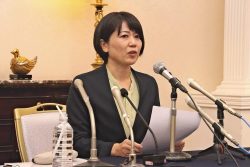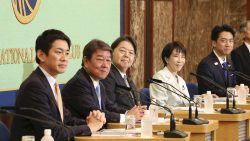
The Diet Building in Chiyoda Ward, Tokyo, Japan.
10:53 JST, June 25, 2021
This is the fifth installment of a series reflecting on the single-seat constituency system over the last 25 years. The following is excerpted from an interview with Kyoto University Prof. Satoshi Machidori.
***
The Yomiuri Shimbun (Q): How has the single-seat constituency system of the House of Representatives changed politics?
Machidori (A): There have been sufficient effects. The basic structure, in which the top two parties in the ruling and opposition blocs compete for support from voters, was not seen in the era of the multimember district system (in which three to five candidates were elected from one electoral district and each voter was allowed to cast a ballot for only one candidate in each of the districts, also known as the so-called medium-size electoral districts).
Although power shifts have not occurred very often, it’s important that the current ruling party always manages its administration knowing that it may lose the reigns of power anytime.
Q: What do you think about the combination with the proportional representation blocs?
A: It has an element that runs counter to a framework consisting of two major parties. In short, the single-seat constituency system encourages political parties to merge, whereas the proportional representation system is a mechanism that prompts them to break up. It makes politicians think that even if they leave a major party, they can be elected in the proportional representation blocs by forming a small party.
The existence of the proportional representation system was an inducement of mass exodus led by Ichiro Ozawa from the then Democratic Party of Japan, when some members clashed with party executives over raising the consumption tax rate in 2012.
When the proportional representation blocs were introduced, they were no more than a bargaining chip of compromise for small political parties that opposed the single-seat constituency system, but the influence still remains.
Q: It has been said that dual candidacies (in both of the electoral domains) have adverse effects.
A: Because even candidates whom voters have rejected at the ballot box can be elected in the other domain, it has a lot of problems. The combination of the two systems has, in effect, a merit that politicians who engage in policies — which may not be favored by the public but should be carried out — can be elected in the proportional representation blocs. But dual candidacies could narrow down room for such politicians to be elected. Overall, the design is not laudable.
Q: The balance of power has changed over the past 25 years in the Liberal Democratic Party.
A: Not only the LDP, but other parties can field one candidate each in one single-seat constituency, so it has decisive meaning for candidates to be endorsed by their parties. The power of party leaders becomes stronger in this mechanism.
In addition, if an election has an impact on the selection of an administration, the evaluations of party leaders directly affect the rise or fall of political parties. Therefore, politicians who think they can get elected thanks to party leaders appear. In this situation, it’s certain that those lawmakers will find it difficult to oppose the party leaders’ intentions.
With former Prime Minister Shinzo Abe, for example, there were not so many people who strongly supported his way of thinking and beliefs. But the LDP won many national elections in a row under his leadership, and the party’s reputation improved. Also, Abe’s approval rating rose. A virtuous cycle occurred, and that cycle supported the Abe administration for seven years and eight months.
Q: How has the disparity of the value of a vote changed?
A: It’s significant that the government established the council for finalizing the constituencies of the House of Representatives (see below) coinciding with the introduction of the single-seat constituency system. The law for the establishment of the council stipulates that vote value disparities should be capped under double, and thus, awareness of the issue rose among concerned entities, including judicial authorities.
Because changes to constituency zonings have increased the number of single-seat constituencies in urban areas, the LDP has had to implement policies strongly focusing on swing voters in urban areas.
Q: Aren’t the voices of people in regional areas being unheeded?
A: This cannot be a reason for tolerating the existence of vote value disparities. If people in regional areas want their opinions to be heeded in central government politics, we should consider such options as overhauling the House of Councilors’ electoral system into, for example, a system for representation by prefecture. Precedents exist in other countries, such as the U.S. Senate.
However, it’s better for us to deeply consider whose opinions are the voices in regional areas. The opinions of local notable people and those in the business community are no more than part of the picture. In our society, there are many minorities, including economically vulnerable people in urban areas, whose voices are not being heard by politicians.
One of the major purposes of electoral system reforms was to have opinions that have not been sufficiently heard reflected in politics by occasionally replacing the people in power.
Q: What should the next electoral system reform be?
A: Ideally, I recommend the introduction of a simple single-seat constituency system in the lower house and a simple proportional representation system in the upper house. The idea is to have the lower house play the role of forming political policies and the upper house reflecting diversified opinions and serving as a check on the lower house’s power. This could mean that the upper house may need to relinquish its functions of forming or ending the power structure through naming prime ministers and submitting censure motions.
—The interview was conducted by Yomiuri Shimbun Staff Writer Yamaguchi Masashi.
The council for finalizing the constituencies of the House of Representatives
This is a government council that makes recommendations to the prime minister about renewing constituency zonings based on populations as determined by national censuses that are taken every 10 years. Its goal is to correct vote value disparities among lower house constituencies.
The council will begin its latest discussions after the preliminary results of the 2020 census are announced in June. It will submit recommendations within a year of the announcement. The law for the establishment of the council sets a basic policy that vote value disparities must be under double and sets criteria that the council should review the zonings “in a rational way while comprehensively considering administrative jurisdictions, geographical factors and traffic conditions, among others.”

Satoshi Machidori, 50, Professor at Kyoto University
After graduating from the Faculty of Law of Kyoto University, he served as an associate professor of Osaka University, among other posts. He has been in his current post since 2007. He specializes in comparative politics. He has written books including “Daigisei Minshushugi (Representative democracy)” published by Chuokoron-Shinsha Inc. and “Seiji Kaikaku Saiko (Reexamining political reform)” published by Shinchosha Publishing Co
"Politics" POPULAR ARTICLE
-

Japan to Support Central Asian Logistics Route That Bypasses Russia, Plan to Be Part of Upcoming Summit in Tokyo
-

Japan to Tighten Screening of Foreigners’ Residential Status by Providing Information of Nonpayment of Taxes
-

Chinese, Russian Bombers Flew Unusual Path by Heading Toward Tokyo; Move Likely Meant to Intimidate Japan
-

Japan Plans National Database to Track Foreign Ownership of Real Estate, Land as It Weighs New Rules
-

Up to 199,000 Deaths Estimated From Mega-Tsunami; Most Recent Occurrence Took Place in 17th Century
JN ACCESS RANKING
-

Tokyo Economic Security Forum to Hold Inaugural Meeting Amid Tense Global Environment
-

Keidanren Chairman Yoshinobu Tsutsui Visits Kashiwazaki-Kariwa Nuclear Power Plant; Inspects New Emergency Safety System
-

Imports of Rare Earths from China Facing Delays, May Be Caused by Deterioration of Japan-China Relations
-

University of Tokyo Professor Discusses Japanese Economic Security in Interview Ahead of Forum
-

Japan Pulls out of Vietnam Nuclear Project, Complicating Hanoi’s Power Plans

























